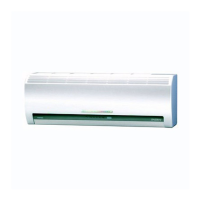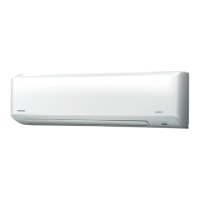
Do you have a question about the Toshiba RAS-13NAX-V and is the answer not in the manual?
| Type | Split System |
|---|---|
| Cooling Capacity | 3.5 kW |
| Heating Capacity | 4.0 kW |
| Power Supply | 220-240V, 50Hz |
| Energy Efficiency Ratio (EER) | 3.21 |
| Coefficient of Performance (COP) | 3.61 |
| Refrigerant | R410A |
| Indoor Unit Dimensions (W x H x D) | 798 x 293 x 230 mm |
| Outdoor Unit Dimensions (W x H x D) | 780 x 550 x 290 mm |
| Indoor Unit Weight | 9 kg |
| Noise Level (Outdoor) | 50 dB(A) |
Detailed diagrams of the indoor unit's physical structure and dimensions.
Detailed diagrams of the outdoor unit's physical structure and dimensions.
Electrical wiring schematic for specific Toshiba air conditioner models.
Electrical wiring schematic for specific Toshiba air conditioner models.
Detailed specifications for indoor unit electrical components.
Detailed specifications for outdoor unit electrical components.
Diagram illustrating the refrigerant flow and components for specific models.
Block diagram showing the control system architecture of the air conditioner.
Overview of how the air conditioner's control system operates.
Explanation of how various operational modes are managed by the control circuit.
Detailed explanation of the high-power operating mode and its functions.
Control logic to prevent overheating by managing indoor heat exchanger temperature.
Procedure and conditions for the defrost cycle in heating mode.
Functionality and setup for automatic unit restart after power interruption.
Description of the self-cleaning feature to reduce internal humidity and prevent mold.
Explanation of the quiet mode operation for reduced noise levels.
Critical safety instructions and precautions for installation.
Visual guide for positioning and mounting indoor and outdoor units.
Specific installation steps and considerations for the indoor unit.
Instructions for performing electrical connections and wiring during installation.
Procedures for installing refrigerant piping and drain hoses correctly.
Specific installation steps and considerations for the outdoor unit.
Detailed steps for connecting refrigerant pipes, including torque specifications.
Procedure for evacuating the refrigerant system using a vacuum pump.
Instructions for setting the remote control selector switch for multi-unit installations.
Method for checking refrigerant gas leaks at connection points.
Procedure for performing a test run of the air conditioner after installation.
General steps and guidelines for troubleshooting air conditioner issues.
Initial checks for power supply, connections, and basic operational parameters.
Methods for initial diagnosis of operational status and potential failures.
Using the remote control for self-diagnosis and interpreting error codes.
Diagnostic flowcharts for various operational problems and fault conditions.
Troubleshooting power issues when the indoor PC board has been replaced.
Steps to diagnose why the outdoor unit is not functioning.
Diagnostic steps for when only the compressor fails to operate.
Diagnostic steps for when only the outdoor fan fails to operate.
Diagnosing issues with the 4-way valve during heating operation.
Diagnostic steps for when only the indoor fan fails to operate.
Troubleshooting steps for remote control and indoor PC board issues.
Procedures for inspecting and testing the air conditioner's printed circuit board.
Step-by-step instructions for replacing parts within the indoor unit.
Step-by-step instructions for replacing parts within the outdoor unit.
Exploded view and parts list for the indoor unit's electronic components.
Exploded view and parts list for a different indoor unit assembly.
Exploded view and parts list for various indoor unit assemblies.
Exploded view and parts list for multiple indoor unit models.
Exploded view and parts list for a specific indoor unit model.
Exploded view and parts list for multiple indoor unit models.











